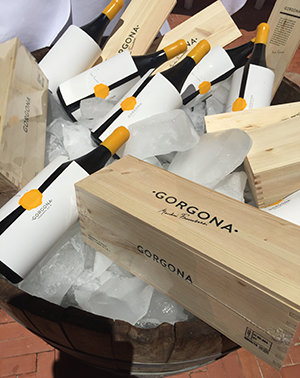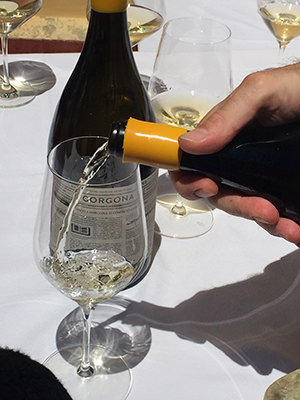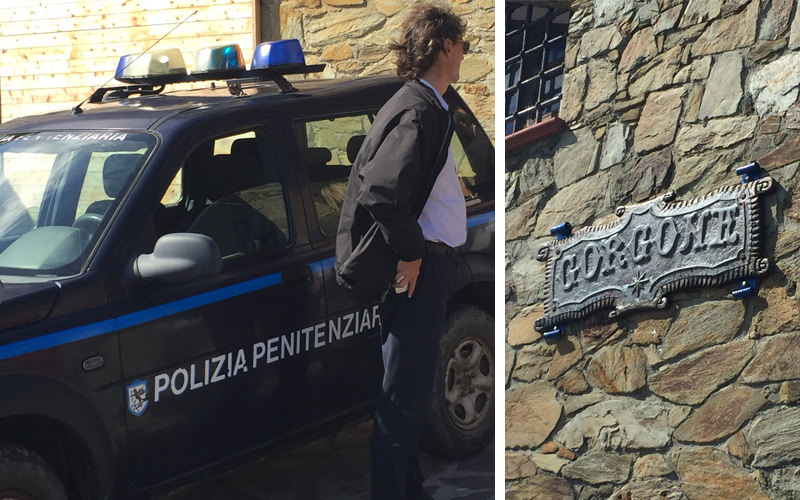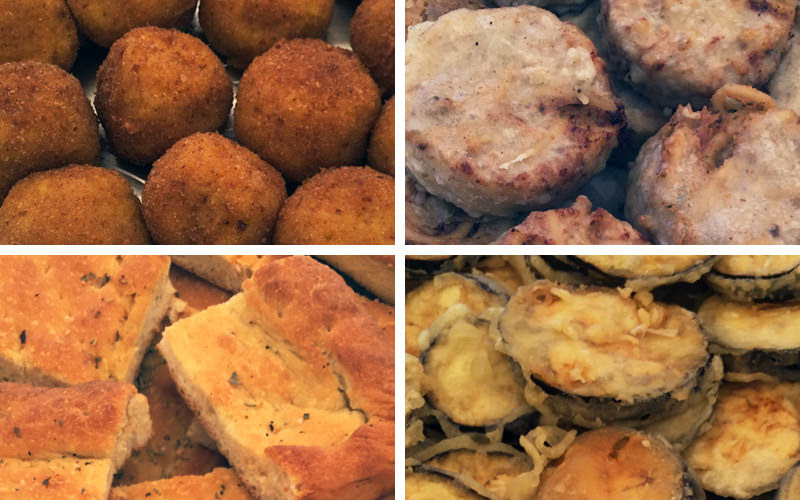The wine, a blend of Vermentino and Ansonica, two native Mediterranean grapes, was a beautiful golden straw in color. There were subtle aromas of crisp apple, acacia and honeysuckle, with hints of pineapple on the nose. The palate had a slight weight to it with well-integrated acidity balanced by clean salinity. There was a kiss of oak, just enough to contribute to the roundness of the wine. And it had been made by prisoners.
With only 4,000 bottles made, this 2015 vintage could definitely be considered a limited-production wine (bottles are available in the United States for about $150, assuming you can find them). Swirling it around in my glass, sipping it with the local cheese and thinking about how wonderful this wine was, I suddenly felt myself getting a little emotional. I wasn’t at some lavish tasting event in New York City, nor was I on some sprawling estate in the hills of Tuscany — well, technically I was in Tuscany but about 18 miles off the coast, on the island of Gorgona, the last prison island in Italy.
A few hours before I had my glass in hand I was ushered onto a ferry in Livorno by the Frescobaldi family to begin an hour-long journey that would introduce me to a project very near and dear to the family’s hearts. A journey that owner Lamberto Frescobaldi takes once a week.
Don't Miss A Drop
Get the latest in beer, wine, and cocktail culture sent straight to your inbox.In 2012, Lamberto received an email from Santina Savoca, the director of the agricultural penal colony on the island of Gorgona. When Santina came on as director she turned her focus to improving agriculture activities on the island, which has had an operational prison since the 19th century. Included in the raising of livestock and farming of fruits and vegetables was a vineyard with a very sparse winery where inmates would make wine. Santina saw an opportunity.
Part of the problem at the prison was that, while the produce was plentiful and the livestock was healthy, the agricultural practices were not controlled and the island was a bit overrun. So Santina made efforts to streamline breeding and introduced dairy production for the first time. Through these changes the inmates learned to focus their gardening and began making their own cheeses.
As things improved, Santina began to reach out to companies on the mainland to supplement the costs of the various programs she had initiated. Her idea was to create partnerships between the prison and these institutions, helping to facilitate real-world training for the inmates. To her dismay her emails fell on deaf ears — until Frescobaldi responded.
For 20 years the prison on Gorgona had been making wine and Santina was seeking help in its production, with the eventual goal of exporting the wine off the island. After receiving her email, Lamberto’s curiosity could not be quelled, so he and Nicolo Afflitto, Frescobaldi’s head of production, took the ferry out to see the winemaking process and taste the wine first-hand. As Lamberto puts it, at the time of their arrival the winemaking program was run by a man who not only had no prior winemaking experience but who was also a devout Muslim, meaning his religion actually forbade him from tasting the wines, leaving no opportunity for quality control. The two tasted the wines and immediately spit them out.
Following the tasting, Lamberto and Nicolo continued to tour the island and the vineyard, getting to know the inmates who worked the land. When Lamberto arrived home in Florence, he couldn’t sleep. The experience had tapped into his emotions and he told his wife that he needed to help. In his mind, the inmates on the island had already been judged and were looking for redemption. He saw that they were very much linked to the land and very proud of the work they were doing on the island. To be transferred to Gorgona, one must be toward the end of a sentence and many of the inmates want to have a skill to bring with them when they are released.
Frescobaldi began to invest in the winemaking program of Gorgona, supplying the prison with new equipment and bringing in Federico Falossi, who had worked in many vineyards across Tuscany, to help train the prisoners in vineyard management and the art of winemaking. They also began to expand the land under vine.
 The inmates became responsible for all aspects of the process, from tilling the sandy soil in the winter to pruning in the summer, becoming involved throughout the growing season from bud break to harvest.
The inmates became responsible for all aspects of the process, from tilling the sandy soil in the winter to pruning in the summer, becoming involved throughout the growing season from bud break to harvest.
Hearing the story about how all of this came to be at a dinner in Livorno the night before we embarked could not have prepared me for what I was about to experience. As we docked in the little fishing village on the eastern coast of the island, we were greeted by a heavy police presence along with inmates in aprons serving us coffee and pastries. As we wound our way through the village we were told that the houses here were for the guards as well as the families of the inmates who were allowed to visit from time to time.
We walked among the huddled houses and apartments. We passed bocce courts, playgrounds and a humble chapel on our way to the top of Gorgona — 200 feet above sea level — and the vineyard. Walking up the steep hills toward the vineyard, it wasn’t until I had seen the prison house that I remembered I was in a penal colony. There was a peacefulness to this place. Thinking of our American prison system, this was definitely a contrast.
That day the vineyard was being tended to by three inmates. I have been in the wine business for over a decade now and have seen my fair share of winemaking and walked many a vineyard row. I have met very passionate people who love what they do, explaining their process with poetic fervor. I saw the same passion in that hectare of Vermentino on that day overlooking the clear blue Ligurian sea. The only difference is that these men were not free. Not yet.
I was able to speak to Churgui, 46, serving out the last two and a half years of his 13-year sentence here on Gorgona. He was happy to see us and talk about how proud he was of his work on the island. One has to be chosen to work in the vineyards and Churgui had spent two years in the garden sector of the island hoping to be a part of this parcel of land. As he trained the vines to compensate for the wind currents that flow over the island, he said he was from Capri and has a family waiting for him there upon. For him, Gorgona is an opportunity to change as a person and gain a skill to take with him when he gets out. Thanks to the island’s agricultural program, Churgui is able to focus on the day he gets out of jail knowing that he has a chance to succeed.
 This is exactly what Santina envisioned when she began reaching out for funding. She says too many times prisoners are released and have difficulty assimilating back into society, with the result a return to life behind bars. Her goal was to give these men skills so that acclimation to freedom was easier and more gratifying.
This is exactly what Santina envisioned when she began reaching out for funding. She says too many times prisoners are released and have difficulty assimilating back into society, with the result a return to life behind bars. Her goal was to give these men skills so that acclimation to freedom was easier and more gratifying.
In the cellar, Federico holds court. The winery, about a 10-minute walk from the vineyard, is one room with just enough equipment to accommodate what they harvest. There is a sorting table and crusher with eight modest stainless steel fermentation tanks and one row of oak barrels. Federico says he was worried when first charged with his new job, not sure he had the skills to teach the inmates, but he has come to really enjoy the process of walking them through the steps of sorting, blending and barreling. Once the barreling is done the wine then is shipped to the Frescobaldi headquarters on the mainland for bottling.
After meeting the local livestock and walking through the well maintained gardens, it was finally time to sample the wine. We headed back into the village to a recreation area where a group of inmates had prepared us a sprawling lunch. The inmates serving us insisted that we try the local cheeses, showing the same pride in their work as we saw in the vineyards. A group of us sat down to taste Gorgona and pair it with the food. As excited as I was to sip this wine, I wasn’t sure what to expect. This was new territory for me. Frescobaldi makes wonderful wine but this was a whole other thing.
When I saw that golden straw color I knew this was going to be a well-made wine. The aromas were so well balanced and incorporated, with not one hint taking center stage. The slight, deep mouthfeel of the wine was as refreshing as the air surrounding the island and was a perfect match with the cheese. Like many white wines, this is one to be consumed young and that is just fine with me. Lamberto told us that two of Gorgona’s former inmates actually have jobs in the wine industry and that’s when the emotion it hit me. I wish we had programs like this in the United States (I found out there was a failed attempt in California). Whatever these men did that brought them here was a ghost of who they are now. From those who served us coffee, to the vineyard workers, to the smiling and laughing group at lunch who had made their own cheese, it was clear that they had been redeemed and were proud to have a skill to take them into the real world.
The production of Gorgona is still quite small but there have been new plantings that will increase the 2019 vintage. Frescobaldi has been a flag bearer and its humanity and investment will inspire more companies to support the efforts and help create new leases on life for the prisoners, thanks to the programs Santina Savoca has created here. Hopefully, other cultures will see this success and follow her path.


